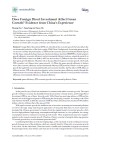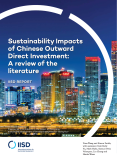
Foreign Direct Investment (FDI) not only affects the economic growth but also affects the environmental protection of the host country. With China’s background of pursuing green growth, we need to consider the performance of FDI from the economic and environmental benefit aspects. On this basis, using slacks-based measure directional distance function (SBMDDF) to build up green growth efficiency, economic efficiency and environmental efficiency indexes, empirical research on FDI in 104 Chinese cities from 2004 to 2011 has shown that: (1) Different cities have differences in their green growth efficiency. Shenzhen city is always efficient in green economic growth. (2) Overall, FDI is positive on Chinese cities’ green growth. (3) When the green growth efficiency is broken down into economic efficiency and environmental efficiency, FDI promotes China’s economic green growth through both environmental benefits and economic benefits. (4) The effect of FDI differs in different sectors. FDI in the emission-intensive sector promotes green efficiency mainly through the improvement of economic efficiency.

Outward direct investment (ODI) by the People’s Republic of China has grown very rapidly since 2004, and in 2014, China’s ODI flows attained USD 123.1 billion. The past decade has witnessed remarkable growth in Chinese outward investments, and there are a growing number of academic studies, policy papers and media reports discussing the operations and impacts of Chinese companies overseas.
This literature review aims to develop a comprehensive understanding of the sustainable impact of Chinese outward investments. The specific objectives of this literature review are:
1. providing a balanced view of the current state of knowledge of the sustainable development impact of Chinese outward direct investment;
2. providing an overview of the diverse perspectives and concerns relevant to Chinese policymakers and companies “going out”;
3. providing insights into the Chinese policy and business strategy measures that would improve outcomes and address concerns;
4. providing direction on further avenues for research and possible future collaboration.
In recent years, China has grown into a major provider of coal power finance in overseas markets, replacing financing by major development institutions. In September 2015, China made a surprise announcement that it would commit to “controlling public investment flowing” into high carbon overseas projects. This was followed by an announcement in November 2015 that OECD countries are committing to common standards for coal subsidies, also potentially significantly restricting international finance for coal power. However, information on overseas coal finance, particularly Chinese finance, has been lacking. CPI has been able to identify China’s role in international coal power generation deployment to provide the most complete estimate of Chinese finance for overseas coal projects to date as well as estimates of the potential impact of China’s recent announcement.
Over the past 30 years, China has developed rapidly to become the world’s second largest economy, reaching the status of a middle-income country. Realizing this success, however, has involved a development approach entailing massive and inefficient resource use, and extensive damage to the quality of air, water and soil. Transforming from a resource- and pollution-intensive economy to a green economy is now a strategic priority for China. Success depends on the development of green industries and the transformation and reduced importance of many traditional industries. Success will be built heavily on green finance, and this is where China is headed.
The aim of this book is to develop specific proposals for greening China’s financial system, based on an analysis of current practice in China and an exchange of experience with international experts. The book proposes a framework for actions covering five key areas that, if adopted by the Chinese government, would promote the systematic development of green finance:
A. Establish and strengthen legal frameworks, including environmental laws and law enforcement that contribute to the demand for green finance.
This synthesis article reviews China's efforts and effects concerning low-carbon green growth (LCGG) and explores the policy implications of reformulating the country's LCGG strategy. The article first reviews China's efforts in four major areas – carbon mitigation, market construction, fostering green industries, and managing the negative effects of LCGG – and then reviews China's LCGG effects with respect to the growth effect and the low-carbon effect. The results show that the increasingly stringent low-carbon policy has not diminished the country's economic growth as some had expected. Rather, the policy has fostered green industries and brought impressive quality improvements, including structural change and increased employment. Although the efforts and effects in China are impressive, the global emissions reduction is far from sufficient to achieve the global climate change target.
